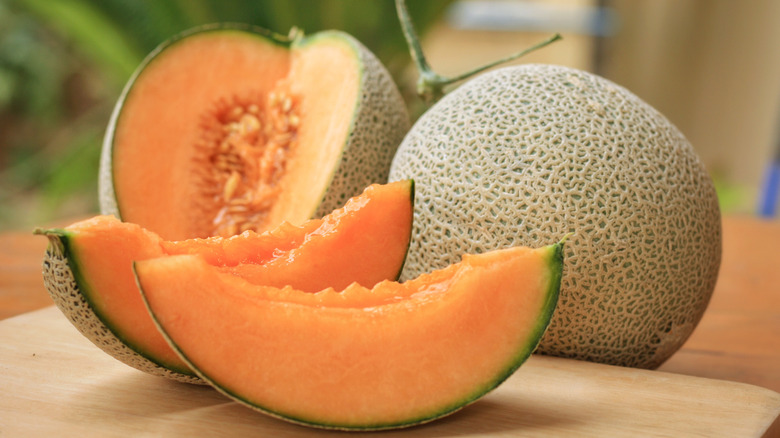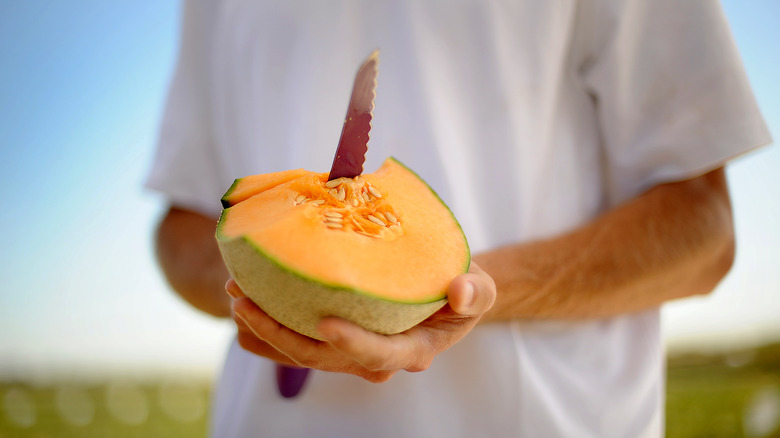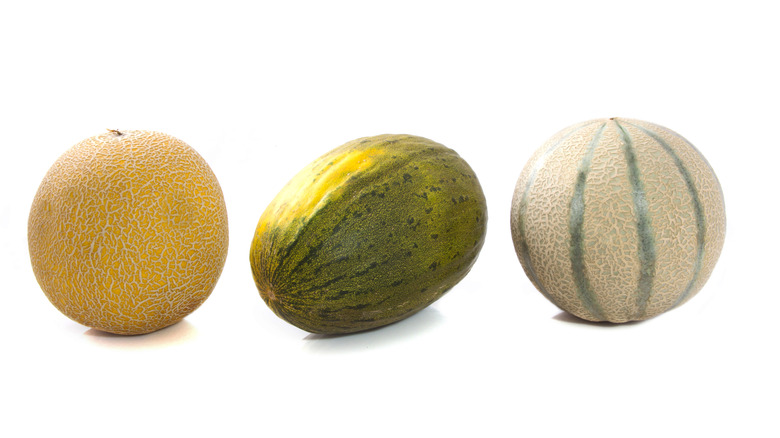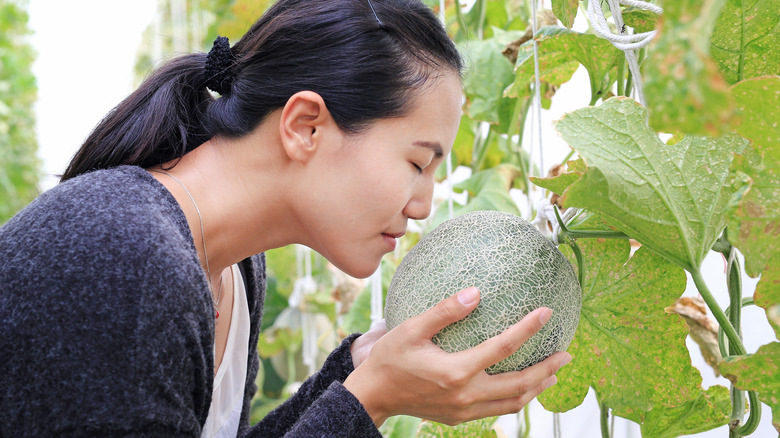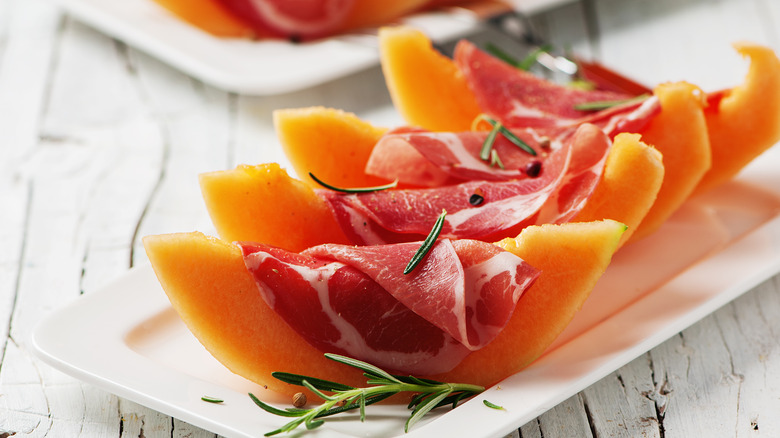What You Should Know Before Buying Another Cantaloupe
Cantaloupe (or Cucumis melo) is a popular variation of muskmelon, and a part of the Cucurbitaceae plant family which also includes most other melons and squashes (via New World Encyclopedia). While it may be a basic breakfast or brunch staple in your home, cantaloupe is popular all over the world as a dessert, side dish, and snack, grown not only in China but also across the Middle East and Europe (via The Spruce Eats).
For such a simple fruit, cantaloupe packs a wallop of health benefits. A one-cup serving of cantaloupe is just 60 calories but contains nearly your full daily requirement of Vitamin C, plus antioxidants like selenium, beta carotene, lutein, zeaxanthin, and choline that help to remove free radicals and prevent cell damage that can lead to cancer and other illnesses (via Medical News Today). The lutein and zeaxanthin can also help filter out damaging rays of blue light (the kind that's constantly blasting at us from our screens), protecting your eyes from more damage. Not only that, but the high levels of Vitamin A and beta carotene may help prevent asthma from developing later in life and even improve skin and hair health, while the fiber, water, and electrolytes in the melon will help keep you hydrated and aid with digestion. But, what is a cantaloupe?
What is cantaloupe?
Melon plants are native to central Asia, though they've spread to warm regions around the world (via Britannica). The cantaloupe, specifically, is a medium-sized, round melon with a textured outer skin, soft, orange flesh, and seeds in the center (via The Spruce Eats). Under-ripe cantaloupe is usually firm and flavorless, while over-ripe cantaloupe will go soft and somewhat mealy in texture. A ripe cantaloupe has firm, juicy flesh and a distinctive sweet flavor.
However, the melon you know as cantaloupe might not be cantaloupe at all! The above description applies to several types of muskmelons and, if you live in North America, it's likely you've actually been eating muskmelon all your life (via The Old Farmer's Almanac). True cantaloupes are more commonly available in Europe, distinct from other muskmelons in their warty-textured exterior, and named for Cantalupo, Italy, where the Asian plant was first cultivated in Europe. In North America, muskmelons are much more commonly cultivated, though they're labeled and marketed as cantaloupes. These are hardly the only muskmelon varieties popular in the world today, however.
Cantaloupe vs Melón de la Mancha vs Yubari King Melon
According to Taste Atlas, of the top 10 most popular melons in the world, variations of cantaloupe make up 70%. These include melons that barely look like cantaloupes at all, such as Melón de Torre Pacheco-Murcia and Melón de la Mancha, which have paler white-green flesh and darker, smoother rinds than the muskmelons with which you're probably familiar. Also on the list is Barattiere, which is described as having the texture of a melon but the taste of a fresh cucumber, with pale green flesh that turns pink when ripe.
Even the more familiar-looking cantaloupe variations have some unique features, like the Melon du Quercy, which is grown in soil rich in lime and clay, giving it strong notes of honey and a softer texture, and the Yubari King, grown in volcanic ash soil in Japan and renowned for its perfectly round shape, smooth skin, and sweet taste, so much so that in 2017 a pair of Yubari King melons sold at auction for $27,000. Fortunately, you don't need to spend that much to enjoy cantaloupe yourself.
Where to buy cantaloupe
In most grocery stores, cantaloupe will be in the produce section near the other melons and should be easily identifiable by its beige/green skin, which has a spider web-like texture (via Infogrocery). Depending on where you live, where you shop, and the current season, one cantaloupe could cost you between $2-$3 (via Walmart). Or, for added convenience (and a slightly higher price), pre-cut cantaloupe could be available in the refrigerated part of the produce section. You'll often find these melons at the store year-round. However, cantaloupe season runs from July through August, sometimes stretching as late as September in warmer climates (via Food Network).
While shopping for cantaloupe, you can't judge a fruit by its rind. Instead, don't be afraid to pick up the melon and check to make sure it's heavy for its size and firm all over, since soft spots are a sign the melon has become over-ripe (via A Pinch of Healthy). Then, give the fruit a sniff. You might look a bit strange, but the best way to identify a ripe melon is by checking for a sweet, musky smell coming off the rind (via Real Simple). If there is no smell, the melon might need to sit on your kitchen counter for a few days to finish ripening.
How to prepare cantaloupe
Once you've identified and purchased a ripe cantaloupe, the first thing you should do is wash the melon thoroughly. While this might seem superfluous when you'll be discarding the rind anyway, washing the cantaloupe before cutting it is crucial, since this will prevent any harmful bacteria on the rind from contaminating the flesh while you're slicing (via Medical News Today).
Anything from salmonella to listeria could be present on the rind of your fresh cantaloupe, so taking the time to wash your melon could save you from some serious food-borne illness (via NPR). Once washed, slice the cantaloupe in half widthwise and use a spoon to scoop out the seeds in the very center of each half. You can discard the seeds, although they are edible and can be stored in the refrigerator until you're ready to clean and roast them (via Food52). Then, cut the fruit into wedges and carefully remove the rind. At this point, you can serve the cantaloupe in any number of ways.
Creative ways to serve cantaloupe
Fresh cantaloupe is delicious all on its own, or added to a fruit salad, but if you're getting tired of these simple staples, here are some new recipe ideas to try out. A great and simple way to show off the sweetness of a cantaloupe is to pair it with a salty, cured meat like prosciutto (pictured above). For even more flavor, some fresh basil, mozzarella cheese, and a drizzle of balsamic glaze will give you an appetizer or side dish that just screams summer (via Delish).
Or, for a super-healthy and vegan-friendly dessert, try sticking some cantaloupe slices on the grill at your next barbecue; this will caramelize the fruit's sugars and deepen its flavor (via This Healthy Table).
Finally, for the ultimate cantaloupe cocktail, cut a melon in half, scoop out the flesh and combine it with some coconut milk, tequila, lime juice, and agave nectar in a blender. Blend the mixture until smooth, then pour it back into the cantaloupe rind with some ice and serve (via Epicurious). This drink is perfect for a taste of tropical vacation when you just can't get away.
